#Kodak Brownie Target Six-20
Text
Old Cameras, part 1!
I love antique cameras. A lot. And lucky for me, they're not particularly rare or expensive, no matter what some people on Etsy might want you to believe :) I have quite a few, all picked up from various garage sales and antique malls, so there will probably be multiple posts. I'm going to start with my Kodaks since that one post about Dracula started this.
The Boxes
At the end of the day, all you need to make a camera is to have something opaque and hollow that your film/light sensitive surface can fit into, and a hole to let light in. These cameras are exactly that, along with a lens to help focus the light for better image control (so called "pinhole" cameras don't even need that!).
In spite of appearances, these are not my oldest cameras.
The Kodak 2a (model C): manufactured between 1924 and 1936
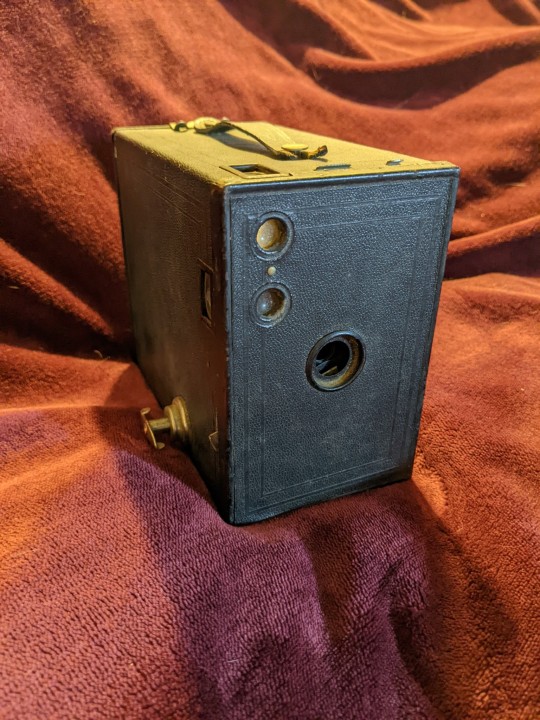
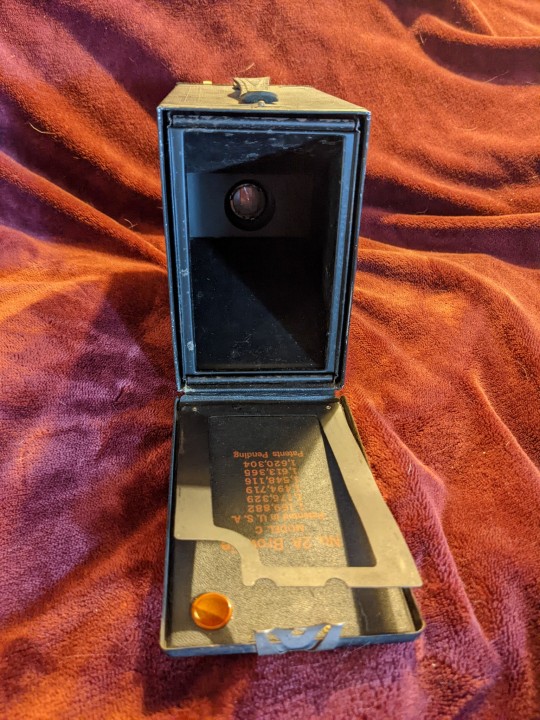
Nothing up my sleeve!
Many early consumer cameras were designed to hold down low, around your stomach, and look down into to aim. You can see the viewfinder at the top left in the first picture here. It's made of cardboard for the most part.
Brownie Junior Six-20: manufactured between 1934 and 1942
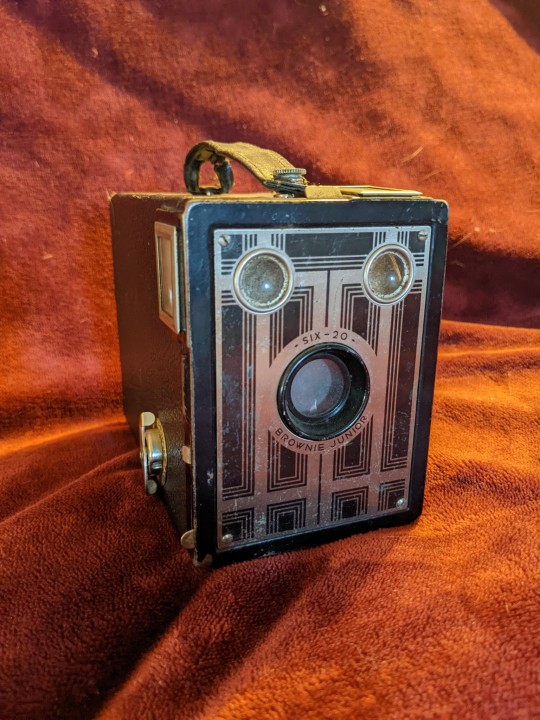
I love the art deco design on the face plate a lot! It's now graduated to a metal body covered with leatherette material.
Brownie Target Six-16: manufactured between 1946 and 1951

Same concept, now with a fully metal body.
The three of them together:

Thanks to @doctorspiral for the nudge to show these around! The next post will feature my pop-out style Kodaks so stay tuned!
#they're just so cool#they've seen so much#sometimes they still have film in them when i get them#i need to find a place who can handle old film one of these days#i bet there are some neat pictures that haven't been seen by anyone for a long long time#cameras#antique cameras#camera history#old kodaks#kodak brownies#doctorspiral#lys don't look#mine#collection bits#photography
45 notes
·
View notes
Text
Kodak vollenda 620 bedienungsanleitung target
KODAK VOLLENDA 620 BEDIENUNGSANLEITUNG TARGET >> DOWNLOAD LINK
vk.cc/c7jKeU
KODAK VOLLENDA 620 BEDIENUNGSANLEITUNG TARGET >> READ ONLINE
bit.do/fSmfG
RoBot 12V Netzgerät SN: 001184 und eine Bedienungsanleitung als Kopie dabei. Vintage Kodak SIX-20 Target Caja Máquina Fotografica Época Xx Sec Kodak N2 A Folding Hawk-eye Model B & Kodak N2 Folding Autographic Kodak Vollenda 620 Faltkamera - Rarität - Vintage Kodak Brownie Target Six-20. Objektivdeckel, Anleitung für Kamera und Philips Vollenda No. 48,. 1932. Kodak/Nagel Kodak Duo 620. "Kodak. Anastigmat", 1937. Kodak, Stuttgart. Mit. Vintage Fotografie - Contax Guide - Kamera-Guide - Bedienungsanleitung - 1946 Kodak Vollenda 620 Vintage Kamera / Klappkamera / 1940er Jahre Vintage Bedienungsanleitungen zu Kodak-Foto- und Filmapparaten finden Sie hier Kodak Junior 620: Eine von vielen 6 x 9-Klappkameras in drei Versionen CERTO Bedienungsanleitung SUPER DOLLINA II Kamera User Manual Anleitung (Y4319 Kodak Vollenda 620 Balgenkamera Klappkamera - Kodak Anastigmat 4.5 10,5cm MAXELL MXSP-BT03 BEDIENUNGSANLEITUNG PHILIPS >> READ ONLINE bit.do/fSmfG .com/post/692558687391432704/kodak-vollenda-620-bedienungsanleitung-polar,21 jam ·. Pentax 67 | Kodak portra 400 | tetenal c41 Eine Kodak Vollenda 620 Basel - Fotografie/Kameras/Zorki 4 - Bedienungsanleitung. G-ST.CH.
https://kebideqolis.tumblr.com/post/692967280681877505/ercolina-top-bender-bedienungsanleitung-polar, https://kebideqolis.tumblr.com/post/692967280681877505/ercolina-top-bender-bedienungsanleitung-polar, https://kebideqolis.tumblr.com/post/692967280681877505/ercolina-top-bender-bedienungsanleitung-polar, https://kebideqolis.tumblr.com/post/692967280681877505/ercolina-top-bender-bedienungsanleitung-polar, https://kebideqolis.tumblr.com/post/692967280681877505/ercolina-top-bender-bedienungsanleitung-polar.
0 notes
Text
Agfa optima 200 sensor bedienungsanleitung target
AGFA OPTIMA 200 SENSOR BEDIENUNGSANLEITUNG TARGET >> DOWNLOAD LINK
vk.cc/c7jKeU
AGFA OPTIMA 200 SENSOR BEDIENUNGSANLEITUNG TARGET >> READ ONLINE
bit.do/fSmfG
analoge blitzgeräte
blitz analoge kamera
Sensor. Objektiv. Linse. Brennweite. Equivalent 35mm Kamera. Lichtstärke. Verschlusszeit AgfaPhoto is used under license of Agfa-Gevaert NV & Co. Mode D'emploi Photo Cinema Original Cine Gel Le Mans Royal 200 Monofilm Agfa Optima 535 Electronic Sensor - Notice D'utilisation En Allemand 22 Pages FC Kaiserslautern AGFA Action Cam Agfa Ansco Box No. Agfamatic 108 Sensor Agfamatic 126 /France Agfamatic 126 /Indien Agfamatic 200 Sensor Agfamatic 200Las mejores ofertas para Agfa optima 1035 sensor buscador cámara están en eBay Agfa Agfamatic 200 sensor Sucherkamera - Color Agnar Parator Optik. Kodak Brownie Target Six-20. € 30 PayLivery Agfa Optima 200 Sensor Color Apotar Paratic. € 15 PayLivery Fotoapparat Agfamatic 3008 Pocket. Das in dieser Anleitung beschriebene Produkt SilverFast® und das Hand- Im Zusammenhang mit dem automatischen Diaeinzug SF-200. Kamera Fotoapparat Kodak Instamatic mit Blitzwürfel Anleitung Tasche schwarz Agfa Optima 200 Sensor Kamera Sucherkamera Color-Apotar Paratic 1:2,8/42.
https://lupupaxet.tumblr.com/post/692035302021267456/7272-fritz-box-handbuch-englisch, https://samimumod.tumblr.com/post/692034800732749824/bedienungsanleitung-sony-icf-2001d, https://lupupaxet.tumblr.com/post/692035302021267456/7272-fritz-box-handbuch-englisch, https://samimumod.tumblr.com/post/692034800732749824/bedienungsanleitung-sony-icf-2001d, https://kenuqeqeb.tumblr.com/post/692035080135344128/philips-cd275-quattro-bedienungsanleitung-deutsch.
0 notes
Link
Vintage 1942 Kodak-Eastman Made in USA. camera medium format. Available in my Poshmark closet- use code REDREADRETALE to open a Postmark account & get $10 off your first order from anyones closet. Or just Ogle this Brownie Beauty :)
#vintage camera#vintage kodak#kodak eastman#antique camera#kodak brownie#camera collectors#set designers#film photography#target six-20 camera#kodak camera#brownie camera
1 note
·
View note
Text
This Mickey Mouse Kodak Brownie is the Disney Camera of Your Dreams
This Mickey Mouse Kodak Brownie is a rare relic from the 1930s.
This rare Mickey Mouse Kodak Brownie Target Six-20 is definitely not one of those toy cameras. Kodak Brownie cameras have become vintage collectibles on their own, but some rare versions occasionally pop up for sale online. Case in point is this Mickey Mouse edition of the Target Six-20 Brownie that was recently listed on ebay for US $7,500. (more…)
View On WordPress
#1930s#Box Camera#eBay#Kodak Brownie#Kodak Brownie Target Six-20#limited edition#Mickey Mouse#Mickey Mouse Kodak Brownie Target Six-20#rare camera#vintage camera
1 note
·
View note
Text
Portraiture Through The Ages
In the 1940′s, camera technology wasn't as advanced as it is to this date, however within this time period, camera technology was considered the most advanced of its time period.
Beginning with the lowest of the low, we have the Kodak Brownie Flash Six-20...

The brownie box, being sold at $6.00 which was introduced in July 1946, is made from a metal box body, with a strange shape. It features an optical direct vision finder, a built-in closeup lens, and time exposure capability. It also accepts a cumbersome flashgun.
The Brownie Flash Six-20 camera was quite a popular camera in its time because of it's indestructibility, taking the place of the modern-day compact or cell phone camera in terms of market penetration.
This camera now sells for around $20-$30.
Up from this, we have the cheap folding cameras like the Agfa Isolette/Ansco Speedex.
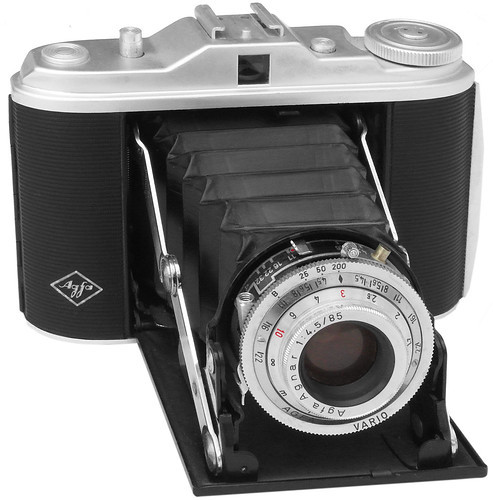

There are two models of the Agfa Isolette, The early model, produced before and during WW2 and the later, produced after WW2. This camera, made by Agfa Kamerawerk AG, Munich, Germany, was named the ‘solders camera’ or ‘Soldatenkamera’. There were many different lens/shutter combinations to this camera, making it impressive in its time period.
The late model was made from 1946 till 1950 with the name writing as Jsolette or Isolette. The camera offered many different lens/shutter combinations, like f/4.5 Agnar, Apotar or Solinar lenses and Prontor, Prontor-S or Compur-Rapidshutters.
This camera costed around $15 back then, but are now sold for around $100-$500.
The Ansco Speedex camera was introduced in early 1940. The camera is labeled on the front as a Agfa B2 Speedex with a 85mm f/4.5 lens. It was actually made in Binghamton, NY when Ansco and Agfa merged. There are no interlock which prevents double exposures.
It is unknown its original price, but it is however sold for around $30-$70 modern day.
We next have the next technological progression, the high-end folding cameras. Equipped with the occasional rangefinder, these devices were even more expensive but were equipped with advanced lenses and shutters. The Kodak monitor 620, is a prime example of these types of cameras.

This camera was introduced between 1939 and 1948, originally sold for $48.50, now selling for around the same price. The camera has advanced features such as an automatic frame counter, double exposure prevention, an uncoupled depth of field scale, and dual viewfinders. This camera was extremely well produced and still is capable of capturing amazing images.
The Leica and their various camera models had produced photojournalism cameras for the international market since the early 1930′s and showed to be productive and effective on the market.

The Leicia IIIc was introduced 1940–1951. This was and still is a very valuable camera model, selling now for around $700-$1000, It was said to have took up 5% of the professional photography market.
Perhaps the most recognisable and famous most used camera of that time was the press cameras, the huge boxy cameras with the wireframe finders and flashbulbs.

These camera targeted 90% of the newspaper photography market 9 out of ten photographers who worked for news agencies chose Graflex models, one of the most popular brands of that time along side Busch (as shown in this image).
These were sold roughly for $3000 alongside with accessories and other gear. These cameras were the best of the best with the manufacturers pulling out all the stops to produce solid press cameras.
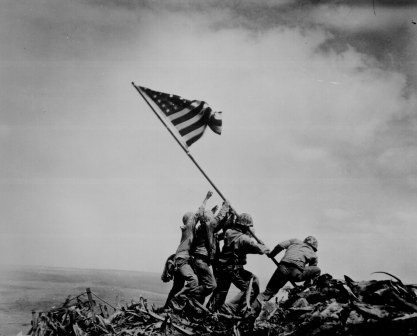
This is an iconic image taken on a Graflex by Joe Rosenthal.
Photographers in the 1940′s

Carl Mydans prepared himself from an early age for his lifelong involvement with journalism. Between 1940 and 1944, Mydans and his wife Shelley Mydans were in Asia, first covering Chungking in its stand against the Japanese bombings, then in Burma, Malaya and the Philippines. While in the Philippines they were both captured by the Japanese and imprisoned for 21 months. This, however, did not deter Mydans, as he went on to photograph many more wartime situations after his release. Mydans recorded photographic images of life and death throughout Europe and Asia during WW2 travelling over 45,000 miles.
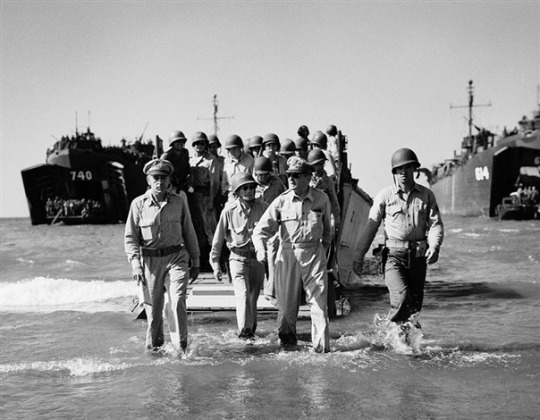
General Douglas MacArthur Landing at Luzon, Philippines, 1945. ‘Blue Beach’, Dagupan, Island of Luzon, Lingayen Gulf, Philippines.

Casualties of a mass-panic during a Japanese air raid in Chongqing in 1941.
Joe Rosenthal spanned more than 50 years, he is best known for a single image: Raising the Flag on Iwo Jima.
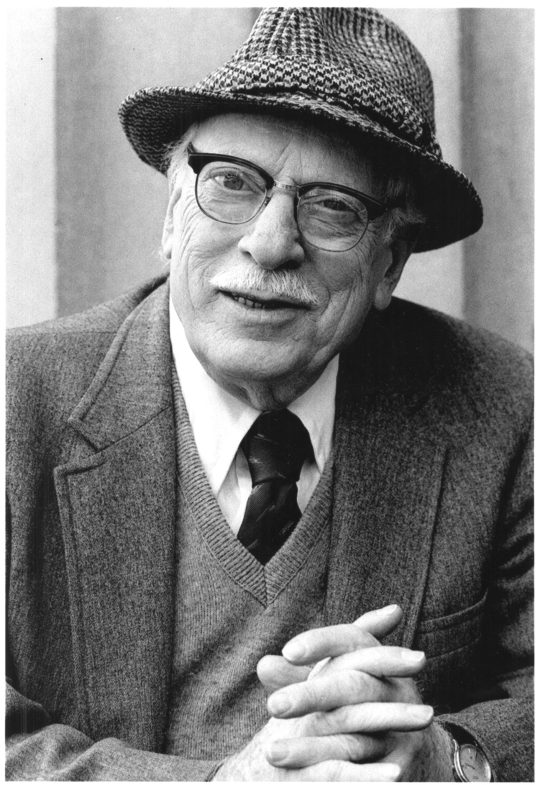
The photograph of six men on a tiny island in the Pacific was immediately a symbol of victory and heroism, and became one of the most famous, most reproduced and even most controversial photographs of all time.

Flag Raising on Iwo Jima, 1945.

U.S. Marines of the 28th Regiment, fifth division, cheer and hold up their rifles after raising the American flag atop Mount Suribachi on Iwo Jima, a volcanic Japanese island, on Feb. 23, 1945 during WW2.
Toni Frissell trained as an actress and worked in advertising before devoting herself to photography.

Frissell had a major contribution to fashion photography in the 1940′s.
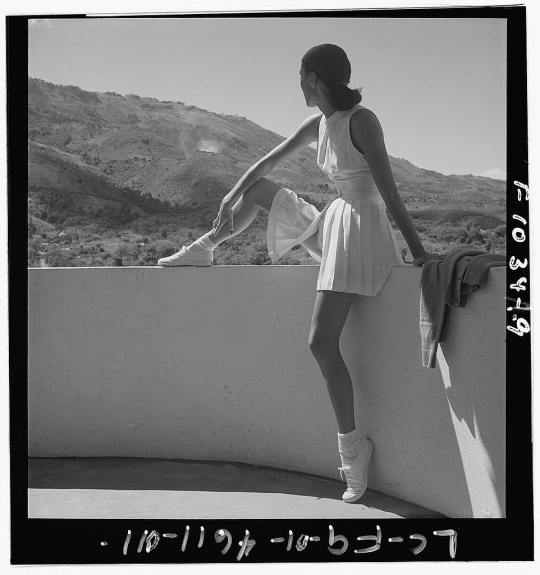
Woman wearing tennis outfit, seated on wall. Toni Frissell. 1947 Febuary.

Eleanor Roosevelt talking with woman machinist during her goodwill tour of Great Britain. Toni Frissell. 1942 November.
Henri Cartier-Bresson is a French photographer, a well-known figure in the history of photography during WW2. His work of spontaneous photographs helped establish photojournalism as an art form.
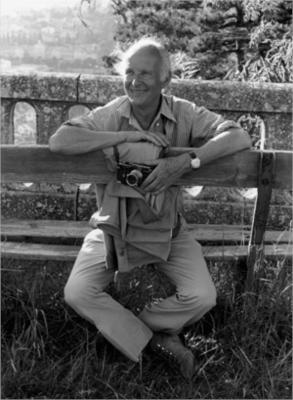
He was imprisoned by the Germans in 1940 during the Battle of France and spent 35 months subjected to forced labour in prisoner-of-war camps until, after several failed attempts, he escaped in 1943.

Germany, WW2, Henri Cartier-Bresson 1945.

Crowd waiting outside a bank to purchase gold during the last days of the Kuomintang, Shanghai, China, December 1948.
A fair amount of photographers during the 1940 period relied on documentary styled images, documenting the drastic happenings of that period of time, until In the period after WW2, as the United States entered a period of domestic peace and prosperity, many photographers there moved away from documentary style photography and focused instead mostly on the intrinsic qualities of photography.
3 notes
·
View notes
Text



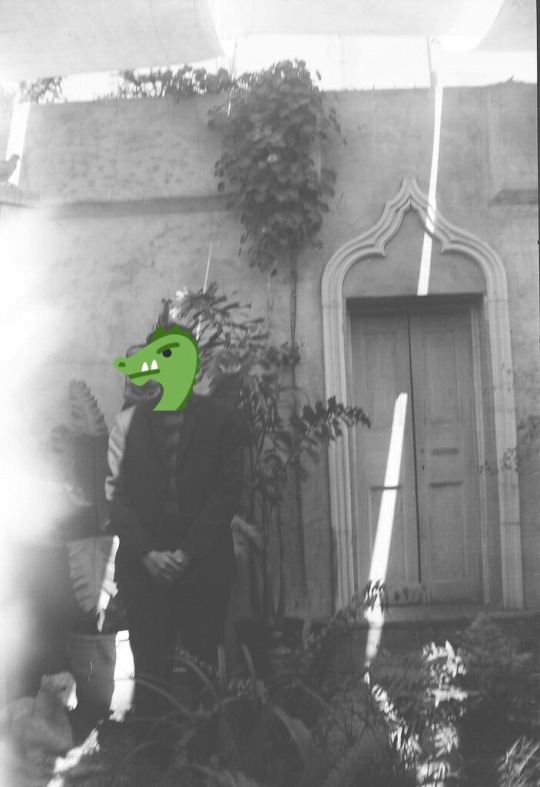


A trip to the Museum of Jurassic Technologies.
Taken with a Brownie Target Six-20 Kodak camera on black and white film
15 notes
·
View notes
Text
Photography Has Changed...
One hundred years ago, photography was obviously not nearly as common as it is today. Photography was on the rise in the early twentieth century, and although it was far cheaper in the 1920s than it was in the beginning of the invention of photography nearly eighty years earlier, it still was not cheap. The cost of the most popular camera in the roaring twenties, the Kodak Brownie, was $5.90. This sounds like a dream price for a camera, even by today’s standards where, adjusted for inflation, this would be about $75.68.

Kodak Brownie Target SIX-20 box camera by Kevin Stanchfield
However, just because photography wasn’t as expensive didn’t mean it was easy. Photographers had to spend time manually focusing their cameras to get the correct shot and developing film for hours on end to get the perfect print. Fast forward to today, a full century later, where we can pull a device from our pocket, aim it at whatever we’d like, and a tiny camera will automatically focus to the subject and the lighting. Then that photo is saved in a digital landscape, no developing and printing required. Frankly, we’re spoiled.
In the last decade or so, photography has taken on almost an entirely new meaning in the art and technology world. Never before did people have access to relatively high quality cameras the way that we do today. Because of this, photography itself has changed. Twenty years ago, if you wanted a photograph of yourself, your family, or anything else, you had to either own a physical camera, or get in touch with someone who did. Taking images of yourself by yourself (what is today known as a “selfie”) was not as simple as looking at a screen that fits in the palm of your hand, it required the set-up of a tripod and a shutter-release system or self timer. Not to mention the subject likely couldn’t see themselves or what the image looked like in the process of taking it. This idea was especially true of those using film, as they likely wouldn’t see the results for a few days, so there was no room to see what the image looked like immediately after taking it to go back and make adjustments.

All Hail Queen Stevie -A photograph of Fleetwood Mac singer Stevie Nicks that she took herself using multiple mirrors- via Little Golden Age on Wordpress
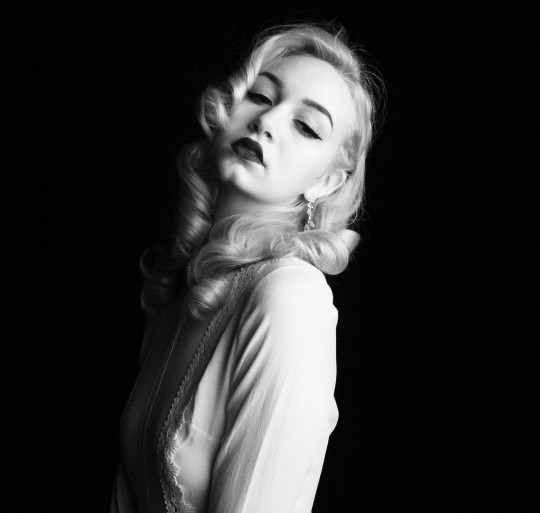
Lovely, a Self Portrait - Image by Author
All of this begs the question: what is considered “art photography” in a time where anyone and everyone is essentially a photographer? Does a photograph that’s taken on an iPhone have any less artistic value than a photograph that’s taken on a high-powered Canon?
Let’s start with one of the main arguments for why the answer to that question might be yes: the quality. The iPhone X and Xs, the two newest iPhones released to the public each have a 12 megapixel camera. This has offered some of the best resolution in photographs that Apple users have ever seen. However, a Canon Rebel T3i, a common camera for amateur to professional photographers, offers 18 megapixels. For those that may not know as much about megapixels, this is a huge jump in overall resolution. A photograph taken with a high-resolution camera will produce an image with much more detail, and in cases of printing, will be a much higher quality print. This may not matter to someone that’s just posting an image on Facebook or Instagram, but that could play into what constitutes a piece of art from just a regular photograph. Sure, a photographer may post their images on Facebook or Instagram just like anyone else, but if an image taken with a cell phone and an image taken with a DSLR camera were hung up next to each other in a museum, for example, there would be a jump in quality between the two.
Color may also play into this equation. In a broad sense, an iPhone camera tends to “blur” colors together, ultimately assuming the colors it sees as it displays them. A DSLR camera is much more exact in the colors it “sees,” often times making the final image have much richer, more true-to-life colors.

iPhone X vs DSLR – Side by Side Comparison! - DavidPlays on YouTube
As you can see in the image above, the colors taken by the DSLR camera are much richer. Although we, the viewer, are not actually there and cannot see what this waterfall looked like in person, it’s safe to say that the image on the right is likely much more true to life than the image on the left. The greens and the red in the rocks specifically point to how a higher-powered camera can produce a much more quality image.
However, there is always a counterargument to every argument. In this case, one could bring up the fact that color, quality, and whatever other qualities a DSLR camera has to offer may not matter at all.
Take, for example, the photographer Francesca Woodman. She was a famous photographer known for her self-portraits during the 1970s and 1980s. This was during a time when film photography was the greatest form of photography that man had ever known, and although color photography was available, Woodman chose to shoot in black and white. A handful of Woodman’s images are grainy due to film quality, out of focus, or contain blurred objects. Yet, she is still considered one of the greatest fine-art photographers of the twentieth century.

The Long Exposure of Francesca Woodman via Elizabeth Gumport
Why? Because of the content of her images. Not just the subjects in them, but the meaning behind them. Deep down, fine art photography is really more about the meaning behind the image rather than the image itself. If an artist can defend their work and give it true meaning and depth, there is no reason why a blurry film photo has more or less fine art quality to it than an extremely sharp and colorful photograph of the same subject. This may plague the fine-art photographer that spent thousands of dollars on a camera set-up that’s destined to get the perfect shot, but their image can be worth just as much, or even less, than a photograph taken on a disposable camera bought at Wal Mart for less than ten dollars. It’s all about the meaning behind the image and the artist who takes it.
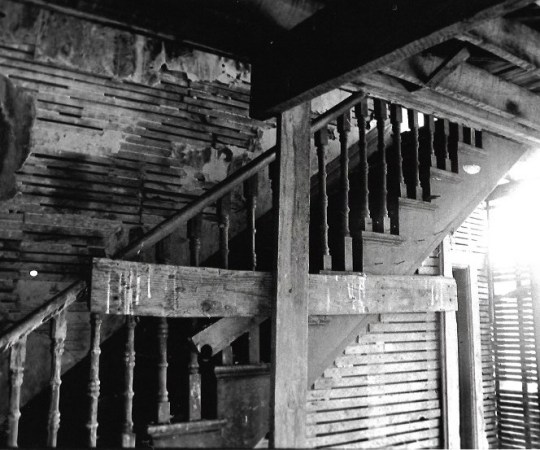
The Worst Image with the Best Meaning - Image by Author
In the end, what constitutes “fine art photography” is in the eye of the beholder. Photography is now a medium that’s available to almost everyone across the globe, for better or worse. What we, the viewer, are responsible for is determining if the meaning behind the photograph is worthy of the image itself.
1 note
·
View note
Link
COME VISIT! - www.acellisllc.com
Art gallery of ACEllisCo. - 001-470-251-5287 – BUY DIGITAL FINE ART! - https://anthony-ellis.pixels.com/ OR http://acellisllc.com
0 notes
Photo

Day 86 of 365 - George Eastman was the inventor of roll film and founded the Eastman Kodak company. He brought photography to the masses with affordable, easy-to-use cameras including these classics Kodaks in my collection. From left to right - the Jiffy Six-16 Series 1 (1933-37), the Brownie Target Six-16, and the Brownie Target Six-20 (1946-1952). In addition to photography Eastman was a major philanthropist, establishing the Eastman School of Music, and schools of dentistry and medicine at the University of Rochester; contributing to the construction of MIT's second campus on the Charles River, and donating to Tuskegee and Hampton universities. For the last two years of his life, he was in intense pain, caused by a degenerative disorder affecting his spine. On March 14, 1932, Eastman died by suicide leaving a note which read, "To my friends: my work is done. Why wait?" #georgeeastman #kodak #cameracollection #cameracollector #photography #photooftheday #365photochallenge #monthofcameras #monochromemadness (at Virginia Beach, Virginia) https://www.instagram.com/p/CNHwnqEBUix/?igshid=zsktjy903y6s
#georgeeastman#kodak#cameracollection#cameracollector#photography#photooftheday#365photochallenge#monthofcameras#monochromemadness
0 notes
Photo
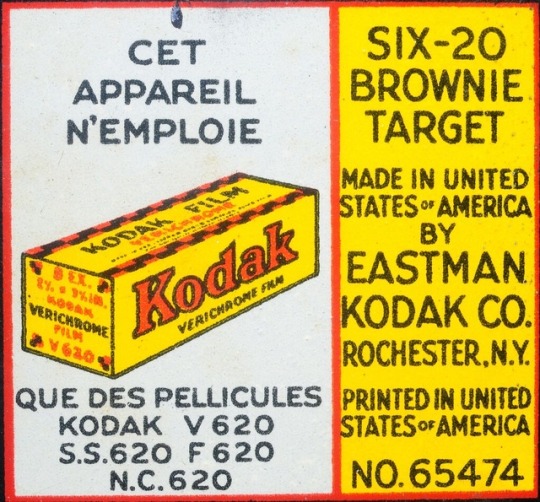
Kodak, Six-20 Brownie Target (États-Unis, circa 1940)
6 notes
·
View notes
Photo

Brownie Target Six-20 Eastman Kodak Company Camera U.S.A. http://rover.ebay.com/rover/1/711-53200-19255-0/1?ff3=2&toolid=10044&campid=5337410323&customid=&lgeo=1&vectorid=229466&item=112507854495
0 notes
Photo

Brownie Target Six-20 Eastman Kodak Company Camera U.S.A. http://rover.ebay.com/rover/1/711-53200-19255-0/1?ff3=2&toolid=10044&campid=5337410323&customid=&lgeo=1&vectorid=229466&item=112507854495
0 notes
Photo

Brownie Target Six-20 Eastman Kodak Company Camera U.S.A. http://rover.ebay.com/rover/1/711-53200-19255-0/1?ff3=2&toolid=10044&campid=5337410323&customid=&lgeo=1&vectorid=229466&item=112507854495
0 notes
Photo

Brownie Target Six-20 Eastman Kodak Company Camera U.S.A. http://rover.ebay.com/rover/1/711-53200-19255-0/1?ff3=2&toolid=10044&campid=5337410323&customid=&lgeo=1&vectorid=229466&item=112507854495
0 notes
Link
COME VISIT! - www.acellisllc.com
Art gallery of ACEllisCo. - 001-470-251-5287 – BUY DIGITAL FINE ART! - https://anthony-ellis.pixels.com/ OR http://acellisllc.com
0 notes